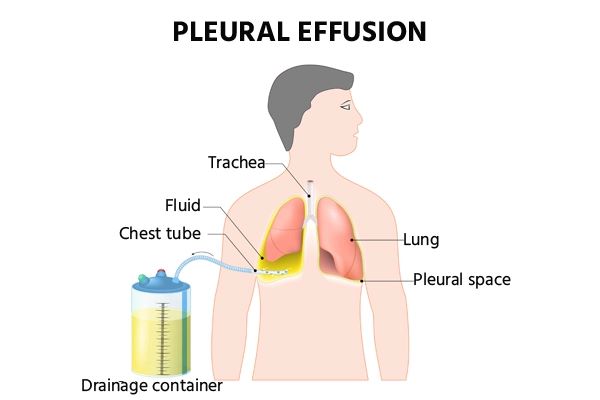
Pleural Effusion
The pleural is the film that lines the thoracic (chest) cavity and covers the lungs. It resembles a huge sheet of tissue that folds over the outside of the lungs and lines within the chest pit. The chest (thoracic or pleural) cavity is a space that is encased by the spine, ribs, and sternum (bosom bone) and is isolated from the midsection by the stomach.
Types of Pleural Diseases
Hemothorax: Accumulation of blood in the pleural cavity.
Pleural effusion: Accumulation of excess fluid in the pleural cavity; this accumulation pushes against the lung and prevents full expansion with breathing.
Pleural Effusion: The accumulation of pus in the pleural cavity. This is a type of pleural effusion that is usually associated with pneumonia (an infection in the adjacent lung).
Pleural tumors: Dangerous cancers emerging from the pleura (for example mesothelioma) or spreading to the pleura (metastatic) from another site, and harmless cancers emerging from the pleura
Pneumothorax: Collection of air inside the pleural pit between the outside of the lung and within the rib confine.
Symptoms of Pleural Effusion
- Chest pain, usually a sharp pain that is worse with cough or deep breaths.
- Cough.
- Fever and chills.
- Hiccups.
- Rapid breathing.
- Shortness of breath.
Causes Of Pleural Effusion
- Pneumonia
- Cancer
- Pulmonary embolism
- Kidney disease
- Inflammatory disease
Treatment of Pleural Effusion
However, if the aspiration is inconclusive and fails to provide an answer, key-hole visualization of inside of the chest (diagnostic thoracoscopy) is the procedure of choice and provide the answer in almost all of the cases.
The Treatment of pleural Effusion primarily depends on the cause: Aim of treating pleural effusion is to treat the cause effectively. Hence pleural effusion due to pneumonia is treated with antibiotics. Pleural Effusion due to tuberculosis is treated with Anti-tubercular Medicines. When the amount of pleural fluid is large and causing breathlessness, drainage of the fluid (Thoracentesis) is done to improve breathing. If it recurs again & again, a chest tube (or a pig tail catheter) may be inserted. Sometimes, the fluid becomes "Pus" and form a layer around the collapsed lung of forms multiple septations in the pus. This condition is now called "Pleural Effusion" (Pus around the Lungs) and need "Decortication" procedure. In this, we remove the thick layer (peel) from around the lung, thereby freeing it up to expand fully. Simultaneously, all the septations are broken, thorough wash is done to clear any infectious material and fresh chest tube is put under vision to drain any re-collection.
Traditionally, this procedure i.e. Decortication is done by Open method which involves cutting muscles & ribs resulting in weeks to months to recovery. We at Centre for Chest Surgery do the "SAME" procedure by Key-hole (VATS) Surgery where the whole procedure is carried out by 2-3 cm size holes, with no cutting of muscles or ribs. Patients have much "less pain" and blood loss and recover much faster, mostly back to work in few weeks, apart from cosmetically better outcome.
Sometimes the fluid accumulates due to involvement of pleura by cancer. In such cases, we drain the fluid by Chest tube to complete Lung expansion & put some chemicals (Pleurodesis) to fuse the pleural layers to prevent recurrence of pleural effusion.

Dr Shashikiran N J
MBBS, MS, MCh
Lead Consultant Minimally Invasive Thoracic surgery
Apollo Hospitals Hyderabad
